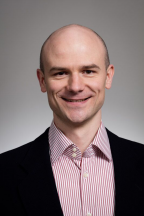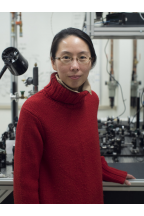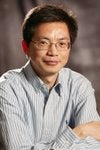Professor Information:
Michal Bajcsy is an Associate Professor in the Department of Electrical and Computer Engineering and has an affiliation with the Institute for Quantum Computing.
Dr. Bajcsy received both his PhD in Applied Physics and his Bachelor of Science in Electrical and Computer Engineering from Harvard University’s School of Engineering and Applied Sciences.
His doctoral work was done under the supervision of Mikhail Lukin and included a demonstration of stationary light pulses and studies of interactions between tightly confined cold atoms and few-photon pulses in a hollow-core photonic-crystal fiber. During his PhD, Dr. Bajcsy spent several years as a visiting student in Vladan Vuletic's group at MIT. He completed his postdoctoral training in the Nanoscale and Quantum Photonics Lab of Jelena Vuckovic at Stanford University, where his research focused on experiments with solid-state cavity QED systems based on quantum dots embedded in photonic crystals.
At the University of Waterloo, he works on development of scalable photonic devices and quantum optics experimental platforms based on quantum emitters such as laser cooled atoms, quantum dots, and color centers coupled to nanophotonic structures.
- Coupling of quantum emitters to nano-photonics structures, Development of on-chip platforms, Non-classical light sources and quantum memories based on mesoscopic ensembles of quantum emitters, Frozen light, dark-state polaritons, all-optical switching at extremely low light levels
Na Young Kim is an Associate Professor in the Department of Electrical and Computer Engineering. She has an affiliation with the Institute for Quantum Computing and and Waterloo Institute for Nanotechnology and cross-appointments with the Department of Physics and Astronomy and the Department of Chemistry.
Na Young leads the Quantum Innovation (QuIN) laboratory, which aims to build large-scale quantum processors based on novel materials and advanced technologies. Two kick-off projects are under way: (1) a semiconductor quantum processors project that establishes controllable optical and electrical domains, in which her research team is learning insights of exotic materials and the fundamental nature of symmetries, and (2) a project in which a multi-functional classical and quantum device arrays establishes a planar architecture comprised of nano-scale devices with electrical, optical, thermal and mechanical functionality.
Prior to joining the University of Waterloo in 2016, Na Young worked for Apple Inc. developing small display products. She received a BS in Physics from Seoul National University and pursued her graduate studies exploring mesoscopic transport properties in low-dimensional nanostructures in the Department of Applied Physics at Stanford University. During her postgraduate research, she expanded her scope to the fields of quantum optics and nanophotonics, working on several experimental and theoretical projects in collaboration with graduate students, postdoctoral scholars and collaborators.
- Large-Scale Solid-State Quantum Computer
- Quantum Simulator
- Quantum Information Processing & Communications
- Quantum Artificial Intelligence
- Quantum Security
- Nanotechnology
Amir Hamed Majedi is a Professor in the Department of Electrical and Computer Engineering, and cross-appointed to the Department of Physics and Astronomy at the University of Waterloo. Professor Majedi leads the Integrated Quantum Optoelectronics Lab (IQOL) within the Waterloo Institute for Nanotechnology.
His main research interests lie within engineering quantum electrodynamics with a focus on superconducting optoelectronics and quantum photonics. His research activities encompass superconducting nanowire single photon detectors, single photon sources based on nanowire quantum dots, superconducting plasmonic detectors and waveguides, superconducting-based quantum dot LEDs for single and entangled photon sources, and graphene photonics.
IQOL pursues theoretical and experimental investigations of quantum and electromagnetic phenomena in superconducting micro-to-nano scale structures to advance optoelectronic, mm-wave/THz and photonic devices and systems. The group aims to develop theoretical foundations, design methodologies, device/system level synthesis, and characterization techniques in order to create superconductive quantum devices for applications that include ultrafast communications and quantum information processing and bio-nanotechnology.
- Quantum photonics
- Superconducting optoelectronics
- Microwave-photonics
- Superconducting & photonic quantum devices
- THz photonic devices
- Systems Electromagnetic band gap structures
- Nano-electrophotonics
- Nano-electrodynamics
- Microwaves & Photonics
- Nano-electronics
- Single-Photon Technology
- Photonics
- Quantum Information Technology
- Quantum Electronics
- Solid-state Quantum Electrodynamics
- Nanotechnology
Michael Reimer joined the Department of Electrical and Computer Engineering in 2015 as an Associate Professor. He has a joint appointment with the Institute for Quantum Computing (IQC).
After receiving his BSc in Physics at the University of Waterloo, Michael spent two years in industry at JDS Uniphase as an R&D Engineer. He then went on to earn his MSc in Engineering Physics at the Technical University of Munich in Germany. In 2010 he obtained his PhD in Physics at the University of Ottawa/National Research Council of Canada.
From 2009 to 2014, Michael was a postdoctoral researcher at Technical University of Delft in the quantum optics lab of Professor Val Zwiller where he developed solid-state quantum devices. During that time, Michael made a huge impact in the development of single photon and entangled photon sources based on shaped nanowire heterostructures, as well as nanowire-based single electron devices and efficient nanowire avalanche photodiodes. In 2013, Michael was also an integral part of a recent start-up company, Single Quantum, developing highly efficient single-photon detectors based on superconducting nanowires.
At the University of Waterloo, Michael is working towards the realization of a quantum repeater, the realization of an efficient interface between stationary and flying quantum bits, performing quantum optics and algorithms on a semiconductor chip, and developing a ‘plug and play’, tunable quantum light source.
- Semiconductor nanowire quantum light sources, Hybrid nanowire quantum state converter, Quantum memories, Integrated quantum photonic circuits, Highly efficient quantum detectors
Christopher Wilson is a professor in the Department of Electrical and Computer Engineering and cross-appointed to the Department of Physics and Astronomy at the University of Waterloo.
In 2004, Professor Wilson moved to Sweden to work on a quantum computing project at Chalmers University of Technology. Along with his team, he started working on superconducting circuits for quantum computing. Around 2007, they realized that the work could allow them to measure the virtual photons inside a vacuum. These virtual photons are generated and annihilated in pairs. About 40 years ago, it was suggested that a mirror moving near the speed of light could capture some of these photons. The effect had never been observed, due to the difficulty of moving a massive object at that speed. They made an electronic 'mirror' that they could effectively move at one-quarter of the speed of light using magnetic fields. This allowed the team to separate the pairs, stopping them from annihilating and turning them into real photons that they could observe.
Professor Wilson is continuing his work on quantum information, microwave quantum optics, and nonlinear dynamics at the University of Waterloo. He has received numerous awards for his research, including the Wallmark Prize for 2012 awarded by the Royal Swedish Academy for his work on the Dynamical Casimir effect (DCE). Professor Wilson’s work on DCE was named in the Top 5 Breakthrough of 2011 by Physics World and #1 Reader's Choice on Nature News.
- Superconductivity
- Superconducting Quantum Circuits
- Quantum Computing
- Circuit quantum electrodynamics
- Microwave quantum optics
- Quantum Information
- Nano-electronics
- Quantum memories and interfaces
- Nonlinear dynamics
Guo-Xing Miao is an Associate Professor in the Electrical and Computer Engineering Department and is cross-appointed to the Institute for Quantum Computing at the University of Waterloo. Professor Miao's research interests lie in spintronics, which use precise electron spin manipulation for information processing. His work places a strong emphasis on nanodevices established on newly emerging spin platforms, such as synthetic diamonds and topological insulators, where information can be processed coherently on the quantum level, rather than digitally on the classical level. The interwined transport of electrons, spins and ions in solid-state devices establishes the forefront for developing semiconductor compatible materials platforms ready for chip integration.
- Topologically quantum computing, Tellurides MBE, Spin memory and logic devices, Spintronics, Iontronics, Resistive switching and neuromorphic computing, Nanotechnology
En-Hui Yang is a Professor in the Department of Electrical and Computer Engineering at the University of Waterloo, and the founding Director of the Leitch-University of Waterloo Multimedia Communications lab. He is also the co-founder of SlipStream Data Inc. (now a subsidiary of BlackBerry Inc. formerly known as Research In Motion), and a past associate editor for IEEE Transactions on Information Theory. Professor Yang is a former Tier 1 Canada Research Chair holder in Information Theory and Multimedia Data Compression.
Professor Yang is the co-developer of the Yang-Kieffer algorithm, a numerical set of rules that use grammar-based coding to achieve lossless compression of text and image files, and also the co-inventor of soft decision quantization (also known as rate distortion optimization quantization or trellis quantization), an efficient coding technology widely used in image/video application related products (such as smart phones, web browsers, etc.) for better compression. With research interests ranging from multimedia compression, information theory, digital communications, image and video coding, image understanding and management, big data analytics, information security, to deep learning, he aims to develop technologies that will enhance the storage capacity of computers, make the transmission of data faster and more reliable, secure data anytime and anywhere, and/or make big data understandable.
He is a Fellow of the Canadian Academy of Engineering, a Fellow of the IEEE, and a Fellow of the Royal Society of Canada. In 2024, for his exceptional scholarly achievement and international pre-eminence, Professor Yang was designated the title 'University Professor' by the University of Waterloo.
- Multimedia Data Compression
- Coding & Modulation
- Information Theory
- Digital Communications
- Description Complexity Theory
- Communication & Information Systems
- Source & Channel Coding
- Image & Video Coding
- Multimedia Communications
- Data Analytics
- Information Security
- Deep Learning
Professor Youngki Yoon is an Associate Professor in the Department of Electrical and Computer Engineering at the University of Waterloo. His research group focuses on understanding physics of non-equilibrium phenomena in nanosystems with relevance to device applications by means of modeling and simulations. Building on rigorous fundamental understanding, he has developed his own quantum transport simulator using Non-Equilibrium Green’s Function (NEGF) method. Atomistic simulations may enable predictive analysis of nanoscale devices for which direct experimental investigation can often be extremely challenging and prohibitively expensive.
He received his Ph.D. in Electrical and Computer Engineering from the University of Florida (Gainesville, FL) in 2008, where his research mainly focused on ballistic transport in carbon nanotube devices. Then he worked as a postdoctoral research at the University of California, Berkeley where he has done pioneering work in the field of non-equilibrium quantum transport, including the first demonstration of dissipative simulation using the NEGF formalism for the realistic size of devices (>200 nm) and the first-ever trial that included both phonon and roughness scattering for graphene nanoribbon transistors.
- Nanoscale transistors and sensors
- Computer simulations for emerging devices
- Engineering tool development for analysis and optimization
General fields of application of the research programs include:
- Quantum photonics
- Quantum optical information processing
- Nanoelectronic-based quantum information processors
- Superconducting quantum devices
- Circuit cavity quantum electrodynamics
- Spintronics
- Quantum optical communication
- Quantum key distribution and hacking
- Quantum information theory and security
- Quantum algorithm
- Quantum complexity
- Quantum communication and fault-tolerant quantum computation







